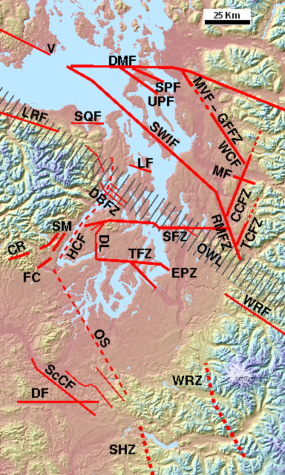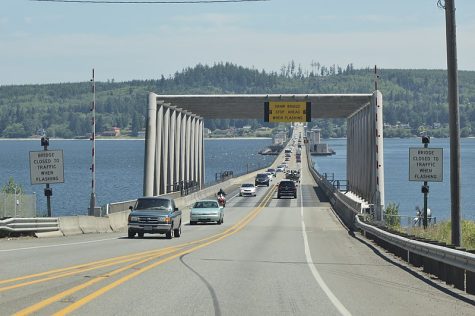Is Kitsap Prepared For ‘The Big One’
Do you know what to do in a natural disaster?
A diagram of the Cascadia Subduction Zone.
Imagine for a second that you’re enjoying a nice sunny day at the Silverdale Waterfront Park. Just staring at the water, not thinking about anything else.
As you’re zoning out, you notice a large amount of seagulls flying away for some unknown reason. You think to yourself, “They probably found some crabs to eat, or something.”
Around 10 seconds later, you feel a very slight, barely noticeable vibration coming from under you. If the seagulls didn’t interrupt your thoughts, you probably wouldn’t have even noticed.
You reassure yourself that it’s probably just some car or truck passing by and choose to ignore it.
Soon after, the vibration becomes stronger, turning into a slight shake to the point where you’re not the only one at the park noticing it. You look over and see the swings on the playground begin to sway a slight bit.
You again think to yourself that it’s not that big of a deal. A small earthquake never hurts anyone.
The park remains relatively silent even with the slight shake until everyone’s phones simultaneously break the silence with an ear-splitting tone.
You see an emergency alert reading, “EARTHQUAKE EARLY ALERT: THE USGS HAS DETECTED A RUPTURE IN THE CASCADIA SUBDUCTION ZONE LEADING TO AN EXTREMELY VIOLENT MEGATHRUST EARTHQUAKE. SHAKING WILL BEGIN IN 30 SECONDS. TAKE NECESSARY PREC-”
Everyone in the park, seeing this alert and already noticing the shaking, began to panic. Some take cover under picnic tables. Some run from the park to get away from the possible tsunami coming into Dyes Inlet later on.
Realistically though, most do not know what to do, nor do they have a plan.
If you were actually in this situation, and not just daydreaming, would you know what to do? Do you have a plan?
In general it seems that Kitsap is not prepared for the upcoming “Big One” as many call it.
To be prepared for the earthquake, one would need to know what it is and how it happens so they can look for signs.
The “Big One” is a recurring megathrust earthquake that is produced when the Subduction Zone between the Juan De Fuca and Pacific Plate rupture. This long subduction zone lines the entirety of Washington and Oregon, as well as Northern California and a chunk of British Columbia, Canada.
Overtime, these two plates move closer and closer towards each other, by a few centimetres a year, slowly building up more and more stress. On average, every 437 years this stress becomes too much for the plates to bear and they rupture, releasing a massive amount of energy.
The resulting megathrust earthquake usually ranks between 8.8-9.2 on the Richter scale. Along with this the rupture also displaces a massive amount of water, causing a large tsunami.

While the interval between now and the last one is shorter than average, that does not rule out the possibility of the earthquake happening at some point close to now.
If it were to happen now with no signs exhibited the effects would be devastating, especially around the Seattle area.
Fema estimates that up to 13,000 people would die with another 27,000 injured. That death toll would make the earthquake the deadliest disaster in US history.
While some people may think that the main thing that would kill people is the large tsunami resulting from the earthquake, similar to the 2011 Tohoku Earthquake, this is not necessarily true.
This is due to the fact that the areas with the largest population such as Portland and Seattle are shielded by natural boundaries which minimize the threat of the tsunami. The tsunami would still be bad though.
The Pacific Coast of Washington, Oregon, and Northern California, would get hit by the tsunami with no doubt that it would leave a large swath of destruction. Because of this many areas on the Pacific Coast are much more prepared for this disaster than areas farther inland.
The main danger to cities like Seattle, Portland, and even areas in Kitsap is the shaking.
In this earthquake, there is so much energy that “shaking” isn’t necessarily the right word to describe the movement but “swaying”. While tall skyscrapers in the Seattle area are fully prepared for the swaying, other buildings aren’t.
Low lying masonry buildings in Seattle would be the main area where death occurs. These buildings would be completely destroyed by the shaking.
In Kitsap the shaking would be even stronger than in Seattle due to proximity to the Subduction Zone. While most buildings in Kitsap are built to earthquake code, some aren’t, similar to Seattle.

Bangor could be even further exasperated by the ensuing tsunami an hour and a half later, that won’t necessarily be as big as the Pacific coast will see, but will be big enough to flood lower base and parts of Silverdale.
Even with this utter devastation though, Kitsap still has plans to help. In general, Kitsap residents are expected to be alone for up to 2 weeks due to everyone experiencing the same disaster, including emergency services. But after that there are plans set in place to help people.
The Kitsap County Department of Emergency Management attempts to prepare Kitsap residents for the upcoming earthquake. One example of this being the Great Shakeout Earthquake Drill that all schools in the State of Washington participated in.
The website also has earthquake education and multiple PDFs showing their plans for the earthquake when it happens.
The best thing an individual can do is prepare themselves. It is not about “if” this earthquake will happen, because it will, it’s about “when”.
Some of the best things you can do to prepare yourself are making an emergency kit to last two weeks, briefing yourself on the tsunami evacuation zones near you, and determining whether your building is earthquake proof or not.
Overall Washington and Kitsap are prepared, but the majority of the citizens in the area are not. But one can be prepared as long as they inform themselves.



